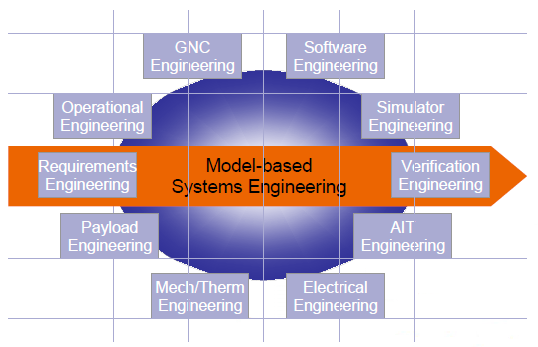The “Virtual Spacecraft Design”
In the ESA led activity “Virtual Spacecraft Design” (VSD) a methodology and an associated framework was developed as a way to improve the organisation of (engineering) data at system level and to allow a smoother exchange of key engineering parameters between different engineering domains and their respective models.
The European Space Agency (ESA) has a recognised track record in building, launching and operating space systems together with its industrial partners. Common systems engineering practices have been standardized in the frame of European Cooperation for Space Standardization (ECSS), that has further contributed to the use of systems engineering activities consistently across organizations, companies and countries.
Almost every project faces the challenge of handling a large amount of data and information available at system and sub-system level and maintaining its coherence and consistency. The efficiency of the system engineering process is still hampered by information being unstructured and not interlinked between different domains. Future challenges include the technical management of increased complexity of systems and systems of systems. While resources are reducing, efficiency must improve to master this system complexity.

Modelling and Simulation (M&S) activities can contribute to address these challenges. Models are used to formalise system aspects in many technical domains. They are also the basis for dynamic simulations to predict behaviour before a system is built. Models – especially software based models – are cheap to build compared to the systems they represent. However, their use today is often limited to the design and analysis phases, and restricted to specific technical areas (such as electrical, functional, mechanical, thermal…). The models are created for specific purposes, and one of the challenges is to ensure the consistency between these models, between the system design information and ultimately the system “as built”. This represents the “backbone” of the proposed MBSE (model-based system engineering) approach for future projects.
In order to demonstrate the benefit of MBSE, VSD addressed the following drivers and demonstrate possible tool support for System Engineering:
- Engineering data representation – the functions of the engineering tools are developed along the needs identified in the different domains. A normally proprietary representation needs to be mapped to an open data representation.
- Data Exchange interfaces- all tools do provide different interfaces to access and exchange purposes. Although standards such as ISO 10303 STEP were considered to provide a common information backbone for data exchange, it is not used in a general manner for data exchange.
- Process Consideration- the nature of the (systems) engineering process is too complex for a mere data exchange solution and requires a sufficient support function to make this exchange happen.
By reducing the inconsistencies and allowing early validation in specific areas, MBSE can increase efficiency of the industrial process. Although it has its function within one company, a specific interest lies also for the Agency, as it represents a common system model representation, enabling consistent exchange of design information and definition of formal system interfaces between partners along the entire life-cycle.
The prototype development of a supporting infrastructure of the Virtual Spacecraft Engineering Environment (VSEE), together with its validation dataset (based on the GOCE mission) is available to users located in the member states of ESA. Please register a user account if you wish to access these prototypes and associated documentation.
